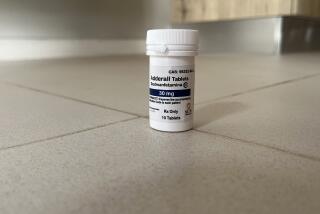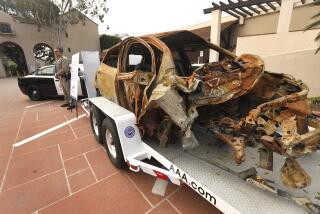Driving While Medicated Can Be Health Hazard
- Share via
Motorists who wouldn’t think of driving after having a couple of beers don’t think twice about getting behind the wheel after taking sedating medicine.
But they should, some recent medical studies have found, because driving under the influence of some medications, even over-the-counter drugs, can be as dangerous as driving drunk.
Until recently, the issue of medicine and its effects on driving received scant attention.
Concerned that commonly taken medicines may lead to more motor vehicle accidents than previously believed, the Food and Drug Administration and the National Transportation Safety Board co-presented a November meeting at which experts debated how best to deal with the potential hazards.
Among the questions experts are asking are whether current warning labels on medicines should be more specific and whether the blood of crash victims should be tested for levels of legal medications.
Regardless of how the debate is resolved, consumers would do well to be more aware of the dangers of mixing legal drugs and driving--and to know that being under the influence of legal medications can be grounds for a traffic citation, just as with being under the influence of alcohol.
Since 1987, the NTSB has investigated more than 100 accidents--involving cars, trucks, buses, boats, planes and trains--that have been attributed at least in part to the drivers’ or operators’ use of over-the-counter or prescription medicines.
That number may appear minuscule in the context of the 6 million-plus police-reported motor vehicle accidents in 2000, but government experts believe it could represent the tip of the iceberg.
“We’ll continue to collect information,” said Lauren Peduzzi, an NTSB spokeswoman.
The NTSB has made several safety recommendations to the Transportation Department and the FDA.
The board asks that toxicology testing be required in a sample of accidents to identify how prevalent a role medications may play in crashes and that the FDA establish an easily recognizable warning label for all prescription and over-the-counter medicines that could interfere with an individual’s ability to drive.
In a study conducted at the University of Iowa, a sedating antihistamine was found to affect driving performance more than alcohol.
Lead author Dr. John M. Weiler, a professor of internal medicine, presented his views at the recent government meeting. In his earlier study, he asked 40 subjects who suffered from ragweed allergy to rate their level of drowsiness while driving on a simulator after taking diphenhydramine (Benadryl) or fexofenadine (Allegra), both over-the-counter antihistamines taken for allergies, and after drinking alcohol or taking a placebo pill.
When subjects took the diphenhydramine, they strayed out of their lanes more often and had worse steering control, for instance, than when they took the fexofenadine, which is a non-sedating antihistamine, or after drinking alcohol. Worse, the subjects’ self-reported drowsiness while on diphenhydramine did not correlate with their description of their performance.
“People don’t realize they are impaired,” Weiler said in an interview.
After Weiler’s report appeared in the Annals of Internal Medicine in March 2000, Harvard University researchers questioned his study design and pointed out that the manufacturer of Allegra helped fund it. But Weiler’s study also was funded by the National Institutes of Health, and he points out that a substantial body of evidence, not just his recent research, links some antihistamines to drowsiness.
Besides antihistamines, many other over-the-counter and prescription medicines can adversely affect drivers, including pain relievers, anti-anxiety medicines and antidepressants, according to an NTSB report on the subject issued in January 2000.
After a 1998 Greyhound bus accident in Pennsylvania that killed the driver and six passengers, a test of the driver’s blood revealed he had taken diphenhydramine before the crash, the NTSB report noted.
Motorists also can get into trouble with muscle relaxants and cold remedies with codeine, said David Nelms, a California Highway Patrol traffic officer and drug recognition expert. He teaches colleagues how to recognize when drivers are impaired, whether from alcohol or over-the-counter, prescription or illegal drugs.
In this state, CHP Officer Bob Granieri said, operating a motor vehicle while under the influence of prescription or over-the-counter drugs that adversely affect driving skills is a violation--the same as driving under the influence of an alcoholic beverage or illegal drug--under Section 23152(a) of the California Vehicle Code. And it does happen, he and other officers say.
Some drivers are unaware of how even a legal drug will affect them.
“People think, ‘The doctor prescribed it; it’s OK,’” Nelms said. But some people take too much, trying to get quick relief from symptoms, he said; others deliberately abuse the drugs.
Some, like those in Weiler’s study, are simply poor judges of how a medicine’s side effects could impair their driving.
Individuals vary greatly in how they react to a medicine, Weiler and others say.
Pharmaceutical industry experts are divided about whether existing labels on drugs need improvement.
“I’d say the labels are adequate, but the labels can also be improved,” said Dr. Bert Spilker, a senior vice president at the Pharmaceutical Research and Manufacturers of America, a trade group for makers of prescription medicine.
One suggestion, he said, is to make the labels more specific, perhaps even including a time period for caution, such as, “Do not drive for four hours after taking this medication.” But he also notes that individuals respond differently to medication.
Dr. Bill Soller, director of science and technology for the Consumer Healthcare Products Assn., a trade group for makers of nonprescription drugs, believes existing labels, which warn of drowsiness and other potentially adverse effects, are adequate. In a survey commissioned by the association, Soller said, 95% of consumers said they read drug warning labels before first-time use.
Even if medicines make drivers drowsy, he said, “there are compensatory mechanisms,” such as turning on the car radio and drinking coffee.
Consumers are becoming more aware of the need to avoid using sedating medicines when they need to drive, said Sona Minas, a registered pharmacist at Sav-On Drugs in Burbank.
“Many customers look for the least-drowsy antihistamine,” she said, and they often seek her advice on which over-the-counter medicine to get.
Until the FDA decides whether more should be done to warn drivers about drugs that might be hazardous, consumers can take label warnings more seriously, Weiler of the University of Iowa said.
If a label warns that impairment or drowsiness are potential side effects or that the user should not operate machinery, he said, “take it seriously.”
*
Good Carma is a guide to automotive-related health and consumer issues. Highway 1 contributor Kathleen Doheny can be reached at kdoheny@compuserve.com.
More to Read
Sign up for Essential California
The most important California stories and recommendations in your inbox every morning.
You may occasionally receive promotional content from the Los Angeles Times.













